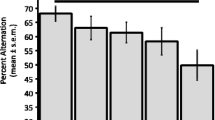Abstract
Two experiments explored the role of the cholinergic system in mediating morphine induced analgesia in the rhesus monkey. Experiment 1 tested for cross-tolerance between two antinociceptive compounds, morphine and scopolamine, using the shock titration technique. Tolerance to morphine attenuated the response to scopolamine but tolerance to scopolamine had no effect on morphine induced antinociception. In Experiment 2, the shock threshold was not modified by injections of scopolamine or arecoline into brain sites which had previously been found to be responsive (in terms of antinociception) to morphine injections. These findings are interpreted to imply that morphine and scopolamine do not exert their antinociceptive effects through identical neural substrates, although Experiment 1 does suggest a certain degree of overlap between such substrates.
Similar content being viewed by others
References
Albe-Fessard, D., Besson, J. M.: Convergent thalamic and cortical projections—the non-specific system. In: Handbook of sensory physiology: somatosensory system, Vol. 2, A.Iggo, ed., pp. 489–560. Berlin-Heidelberg-New York: 1966.
Beleslin, D., Polak, R. L.: Depression by morphine and chloralose of acetylcholine release from the cat's brain. J. Physiol. (Lond.) 177, 411–419 (1965)
Bhargava, U. N., Way, E. L.: Acetylcholinesterase inhibition and morphine effects in morphine tolerant and dependent mice. J. Pharmacol. exp. Ther. 183, 31–40 (1972)
Bradley, P. B., Key, B. J.: A comparative study of the effects of drugs on the arousal system of the brain. Brit. J. Pharmacol. 14, 340–349 (1959)
Bradley, P. B., Wolstencroft, J. H.: Effects of acetylcholine, nicotine, and muscarine on brainstem neurons. Ann. N. Y. Acad. Sci. 142, 15–20 (1967)
de Jongh, D. K.: Remarks on the mechanism of analgesic action of morphine. Acta physiol. Pharmacol. neer. 3, 164–172 (1954)
Denisenko, D. P.: Pharmacological blocking of central cholinoreactive systems and the possibilities of its therapeutic application. In: Pharmacology of cholinergic and adrenergic transmission. G. B. Koelle, W. W. Douglas, A. Carlson, and V. Trcka, eds. New York: MacMillan 1965
Harris, L. S.: Central neurohumoral systems involved with narcotic agonists and antagonists. Fed. Proc. 29, 28–32 (1970)
Harris, L. S., Dewey, W. L., Howes, J. F., Kennedy, J. S., Pars, H.: Narcotic-antagonist analgesics: interactions with cholinergic systems. J. Pharmacol. exp. Ther. 169, 17–22 (1969)
Hug, C. C.: Characteristics and theories related to acute and chronic tolerance development. In: Chemical and biological aspects of drug Dependence. S. J. Mulé and H. Brill, eds., pp. 307–358. Cleveland: CRC Press 1972
Ireson, J. D.: A comparison of the antinociceptive actions of cholinomimetic and morphine-like drugs. Brit. J. Pharmacol. 40, 92–101 (1970)
Jhamandas, K., Phillis, J. W., Pinsky, C.: Effects of narcotic analgesics and antagonists on the in vivo release of acetylcholine from the cerebral cortex of the cat. Brit. J. Pharmacol. 43, 53–66 (1971)
Killam, E. K.: Pharmacology of the reticular formation. In: Psycho-Pharmacology. A review of progress. D. H. Efron et al., eds. PHS Publication No. 1836. Washington, D. C.: US Government Printing Office 1968
Krug, M., Schmidt, J., Matthies, H.: Beeinflussung des Impulsmusters von spontan tÄtigen Neuronen der Pontine formatio reticularis der Ratte durch Noradrenalin, Serotonin und Azetylcholin. Acta biol. med. germ. 25, 455–467
Krupp, P., Monnier, M.: The unspecific intralaminary modulating system of the thalamus. In: International review of neurobiology. C. C. Pfeiffer and J. R. Smythies, eds., Vol. 9. New York: Academic Press 1966
Little, J. J., Rees, J. M. H.: Tolerance development to the antinociceptive actions of morphine, amphetamine, physostigmine and 2-aminoindane in the mouse. Experientia (Basel) 30, 930–932 (1974)
Martin, W. R.: Pharmacological redundancy as an adaptive mechanism in the central nervous system. Fed. Proc. 29, 13–18 (1970)
Metys, J., Wagner, N., Metysova, J., Herz, A.: Studies on the central antinociceptive action of cholinomimetic agents. Int. J. Neuropharmacol. 8, 413–425 (1969)
Nauta, W. J. H.: Hippocampal projections and related neural pathways to the midbrain in the cat. Brain 81, 319–340 (1958)
Paton, W. D. M.: The action of morphine and related substances on contraction and on acetylcholine output of coaxially stimulated guinea-pig ileum. Brit. J. Pharmacol. 12, 119–127 (1957)
Pert, A.: The cholinergic system and nociception in the primate: Interactions with morphine. Psychopharmacologia (Berl.) 44, 131–137 (1975)
Pert, A., Yaksh, T.: Sites of morphine induced analgesia in the primate brain: relation to pain pathways. Brain Res. 80, 135–140 (1974)
Pleuvry, B. J.: Cross-tolerance between methylamphetamine and morphine in the mouse. J. Pharmacol. 23, 969–970 (1971)
Pleuvry, B. J., Tobias, M. A.: Comparison of the antinociceptive activities of physostigmine, oxotremorine and morphine in the mouse. Brit. J. Pharmacol. 43, 706–714 (1971)
Seevers, M. H., Deneau, G. A.: Physiological aspects of tolerance and physical dependence. In: Physiological pharmacology. W. S. Roat and F. G. Hofmann, eds., pp. 565 to 640. New York: Academic Press 1963
Schaumann, N.: Inhibition by morphine of the release of acetylcholine from the intestine of the guinea-pig. Brit. J. Pharmacol. 12, 115–118 (1957)
Shute, C. C. D., Lewis, P. R.: Cholinesterase-containing pathways of the hindbrain: afferent cerebellar and centrifugal cochlear fibres. Nature (Lond.) 205, 242–246 (1965)
Weiss, B., Laties, V. G.: The psychophysics of pain and analgesia in animals. In: Animal psychophysics. The design and conduct of sensory experiments, W. C. Stebbins, ed., pp. 185–210. New York: Appleton-Century-Crofts 1970
Yarbrough, G. G.: Actions of acetylcholine and atropine on cerebral cortical neurons in chronically morphine-treated rats. Life Sci. 15, 1523–1529 (1974)
Author information
Authors and Affiliations
Additional information
In conducting the research described in this report, the investigators adhered to the “Guide for the Care and Use of Laboratory Animals” as promulgated by the Committee on Revision of the Guide for Laboratory Animals Facilities and Care of the Institute of Laboratory Animal Resources, National Research Council.
Rights and permissions
About this article
Cite this article
Pert, A., Maxey, G. Asymmetrical cross-tolerance between morphine and scopolamine induced antinociception in the primate: Differential sites of action. Psychopharmacologia 44, 139–145 (1975). https://doi.org/10.1007/BF00421000
Received:
Revised:
Issue Date:
DOI: https://doi.org/10.1007/BF00421000




